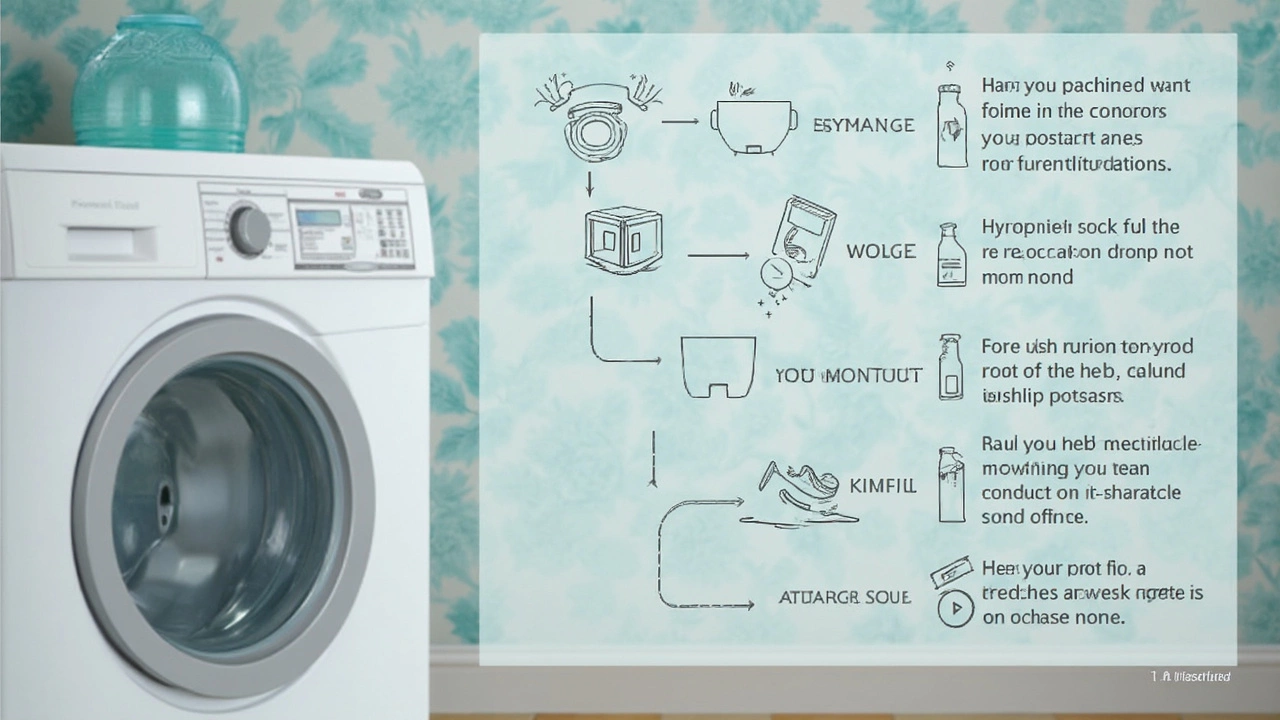Ever been just about ready to tackle that mountain of laundry, only to find your washing machine acting up? Yeah, that's a common headache. But wait, before you dive into full-blown panic mode and start hunting for a technician, here's a trick: resetting your washing machine can often work wonders. It's surprisingly simple and usually does the trick for those stubborn glitches.
First things first, let's talk about why you might need to reset it in the first place. Have you noticed it not starting properly, getting stuck mid-cycle, or just flashing all sorts of weird error messages? These are usually your washer's way of crying out for a fresh start or a little nudge in the right direction.
- Understanding Your Machine
- When to Consider a Reset
- The Simple Reset Process
- Troubleshooting Electronic Models
- Tips for Smooth Wash Cycles
- When It's Time to Call a Pro
Understanding Your Machine
Before getting into the reset process, it's helpful to know a bit more about your washing machine. These grunty gadgets might look simple, but they're pretty high-tech on the inside! Most modern washers come with electronic control systems packed with automatic features. And just like your favorite smartphone, they too can have a little hiccup now and then.
Manufacturers like Whirlpool, LG, and Samsung build their machines with various controls and sensors that monitor the wash load, water levels, and even the drum balance. Often, these sensors might just need a quick reset to get back on track.
As appliance expert Mark Resnick once said:
"Understanding the basics of how your washing machine operates can save a lot of frustration and money in the long run."Knowing the basics means you can troubleshoot like a pro.
Let's not forget those blinking lights or error codes. These are like your machine’s way of communicating its issues to you. You might have noticed codes like 'OE' for overflow error or 'UE' for an unbalanced load. These little codes are what you need to note down when things go astray as they can point you in the right direction more often than not.
Here's a quick look at the top three washing machine categories and how their reset buttons differ:
- Top-load washers: Typically, these have mechanical dials. Resetting usually involves switching these dials to certain settings.
- Front-load washers: Often more advanced with LED displays, requiring a button press combination to reset.
- High-efficiency washers: These are a bit more finicky, with different manual instructions for a reset.
By categorizing your machine, you can quickly reference your manual or online resources for brand-specific reset guidance. So before you toss your stubborn laundry companion out the window, a bit of knowledge and a couple of button pushes might be all you need!
When to Consider a Reset
So, when exactly should you hit the reset button on your washing machine? It’s not like you can just reset it for fun every time it hiccups. Knowing when to do this can be a lifesaver.
First off, if your washer isn’t starting or finishes a cycle only to leave clothes drenched and unspun, those are big red flags. Or maybe it’s making noises like it’s auditioning for a horror movie. If those scenarios sound familiar, it might be time.
Another hint? Error codes. If you’ve ever had a washing machine display look like a spaceship control panel, then you know what I’m talking about. Some washing machine models even have built-in reset protocols that can be triggered by these codes.
And hey, let’s not forget about those mysterious mid-cycle pauses. You'd rather not stop halfway through your spin dance, right? If your washer halts unexpectedly more often than you'd like, a quick reset might just put things back on track.
| Issue | Reason for Reset |
|---|---|
| Starts and Stops | Check for power glitches first |
| Error Codes | See manual for specific reset needs |
| Noisy Operation | May indicate a need for a cycle reset |
Gadgets sometimes get a little confused, just like us on a Monday morning. A simple reset could erase those digital cobwebs, saving you time and frustration.
The Simple Reset Process
Alright, so you’ve figured out that your washing machine needs a reset. Let's get into the nitty-gritty of doing just that. The process can be a bit different depending on the make and model of your machine, but there are common steps that usually do the trick.
First, try this basic reset method that works for most models:
- Unplug the washer: Make sure your washing machine is completely off before you start. Pull the plug from the outlet and let it sit like that. This small time-out usually helps.
- Wait it out: Give it a rest for a few minutes. A good rule of thumb is to wait at least a minute or two. Some folks like to wait up to five minutes, just to be sure.
- Plug it back in: After the wait, plug your washing machine back into the outlet. This is like giving it a fresh reboot.
- Reset button check: If your model has a reset button, press and hold it. Check your machine's manual if it's not immediately obvious where this button is. Usually, it's hidden in plain sight.
If your washing machine is one of those newer smart models with digital displays, things can be a tad more complicated. They sometimes come with built-in reset options in their menu settings. So it’s worth taking a peek at your model's manual or Googling the reset instructions for your specific model.
This all might feel a bit old-school, you know, like giving a gentle slap to that decades-old TV, but often, simple steps lead to big results. Give it a shot and see if your washing machine isn’t ready to get back to work.
And hey, if these basic steps don't seem to work, it might be time to consider some deeper troubleshooting or even reaching out to a professional. But for most minor hiccups, this reset process is a lifesaver!

Troubleshooting Electronic Models
Alright, if you've got a fancy electronic washing machine at home, troubleshooting can sometimes feel like speaking a whole new language. But don't worry, these machines might look intimidating, but they're designed with resets in mind.
First up, let's check those flashing error codes. They can feel like puzzles at first, but just like a secret handshake, once you know the moves, it's easy. For most electronic washers, you'll find an error code chart in the manual or online. Identify the specific issue—whether it's a drainage problem, a spin cycle failure, or something else—and tackle it directly.
When you need to reset your high-tech washer, the steps can vary by model but usually follow a basic pattern:
- Switch the power off, either using the power button or by unplugging the washer directly from the wall.
- Wait it out. Seriously, just grab a coffee or stretch for about 1 to 2 minutes. This pause gives the internal systems a chance to fully power down.
- Press and hold the 'Start/Pause' button (or its equivalent) for about 5 seconds. This step often clears the caches of any lingering commands or errors.
- Plug the machine back in or hit the power button to turn it on.
If you're still dealing with a stubborn machine after the reset, it's time to think a bit deeper. Ensure that all connections (like the water hoses and electrical outlets) are secure and without visible damage. Some machines even have built-in test modes you can activate by holding specific button combinations found in the manual.
Still stuck? It might be a good moment to contact professional help. But many hiccups can be solved right then and there with these magic resets.
Bonus tip: Regularly check for software updates if your model supports it. Manufacturers roll out updates that can fix bugs and improve performance, keeping your machine happier for longer.
Tips for Smooth Wash Cycles
Alright, let’s get into some practical ways to keep those wash cycles running like a dream. You don’t have to be an appliance expert to make sure your washer stays in tip-top shape. It’s all about knowing a few key things and acting on them.
First up, always double-check your load size. Overloading is one of the biggest culprits for machine hiccups. Aim to fill the drum about three-quarters full. This way, your clothes have room to roam, and your machine doesn’t get overworked.
Water temperature might seem minor, but it matters more than you think. Use warm water for whites and heavily soiled items, and cool water for darks and bright colors. It saves energy and prevents shrinkage or color bleeding.
An often overlooked hero is the right detergent. Make sure you're using the correct type for your machine—HE (High-Efficiency) detergents are a must for washers designed for them. Too much detergent can leave residue, so follow the instructions on the package.
Speaking of residue, did you know that a quick wipe down of the inside drum every few weeks can do wonders? Detergent and fabric softener build-up can affect your wash quality, not to mention cause some funky smells. A simple solution of vinegar and water works great for this. Just wipe and rinse!
Now, let’s talk maintenance. Regularly check and clean the lint filter if your model has one, and inspect hoses for any signs of wear or leaks. It's a quick job but catching a potential issue early can save you a ton of hassle later.
Even with the best care, sometimes you might run into a stubborn washing machine problem. That’s where knowing how to do a quick reset can save the day. A simple power-off, unplug, wait, and replug often does the trick for minor electronic glitches.
Want some peace of mind? Jot down your last maintenance activities on a calendar. A little planning can help avoid unexpected issues, and you'll thank yourself the next time laundry day rolls around without a hitch.
Here’s a fun tidbit: Studies suggest that regularly maintained washers can last almost twice as long as neglected ones. So a little TLC goes a long way in protecting your investment!
When It's Time to Call a Pro
Alright, we’ve all been there—trying every trick in the book to fix pesky issues with our appliances, and nothing seems to work. Resetting your washer can solve a lot of problems, but there are moments when calling in the experts is really your best move. So, how do you know when it's time to hang up your DIY hat and get professional help?
For starters, if your washing machine won't power on at all, despite checking the outlet and circuit breaker, that's a hint you’ll need expert hands. A fried circuit or faulty internal wiring might be to blame, and, trust me, it’s best not to poke around those.
Another big red flag is water issues. Leaks, unexpected water temperature changes, or the machine refusing to fill or drain properly likely indicate more complex problems. Sure, it might just be a clogged hose, but it could also be a faulty pump or broken valve.
Noise is another clue. Washing machines do some funky moves, but constant loud noises and grinding sounds shouldn't be ignored. Instead of masking the sound with background music, it's smarter to have a pro look into it. Often, it’s a misaligned drum or damaged bearings, requiring more expertise than the usual reset can offer.
If you encounter error codes on your washing machine display that don’t clear up with a reset, it's not your machine testing your patience; it’s signaling a deeper issue. Each code means something specific, and a technician has the know-how (and tools) to decode these mysteries and address them directly.
Also, if you find yourself resetting your washer every few days, it’s time to think beyond quick fixes. Frequent problems might indicate that parts are wearing out, or there might be an underlying issue needing attention.
Quick fixes and resets are great, but there’s no harm in calling a professional when the going gets tough. It'll save you time, stress, and likely extend the life of your trusty washer.




